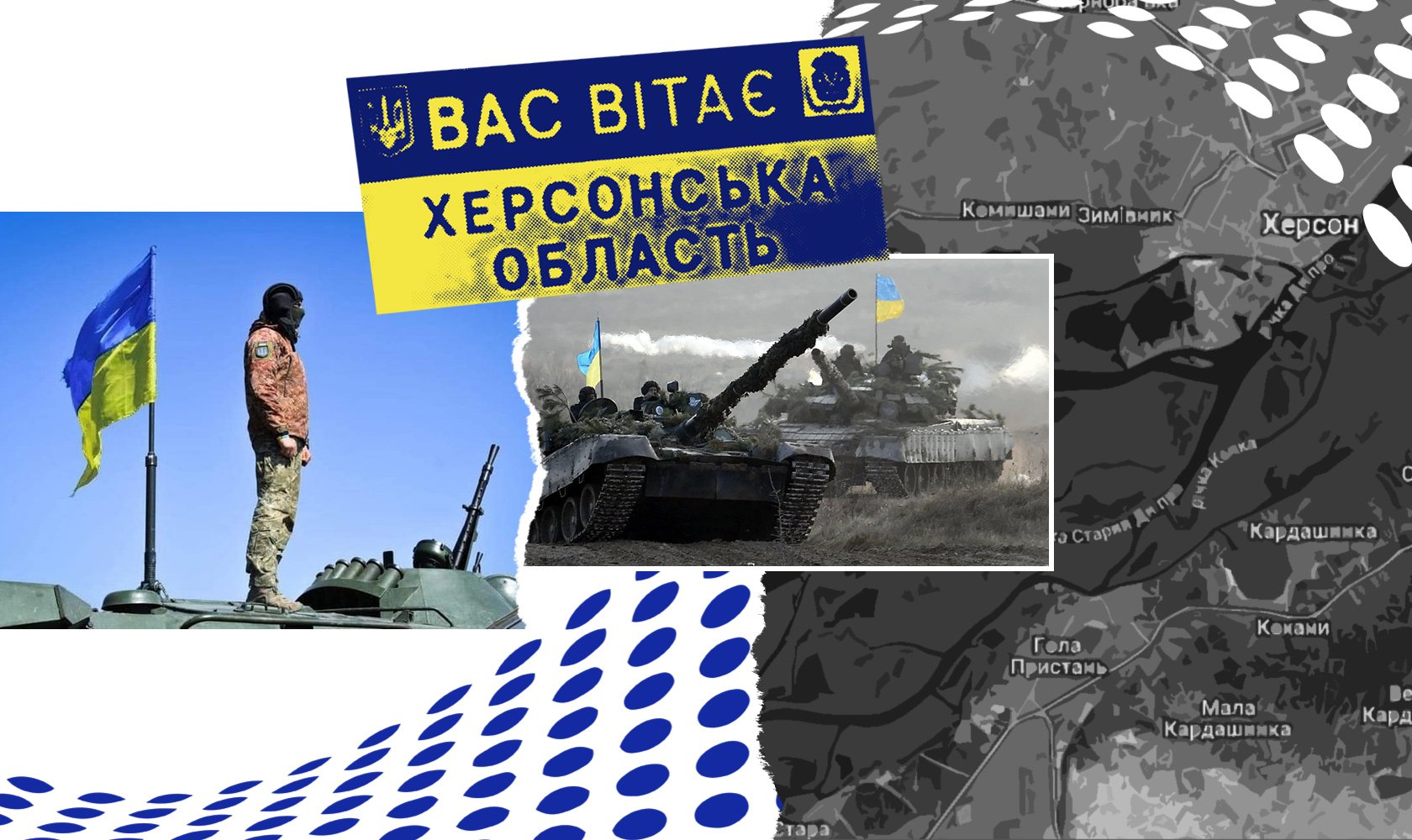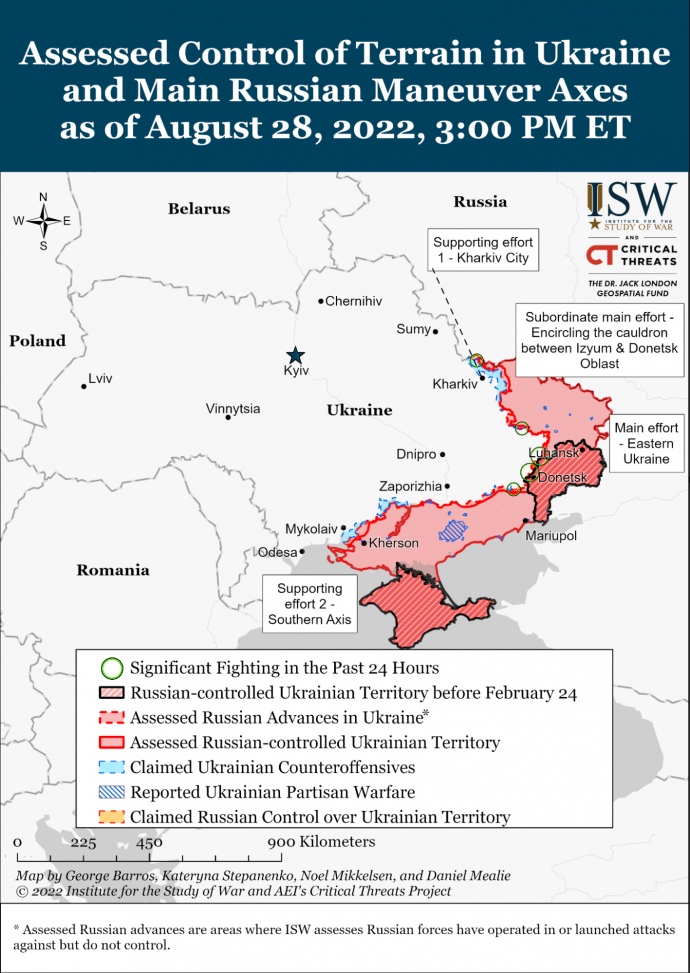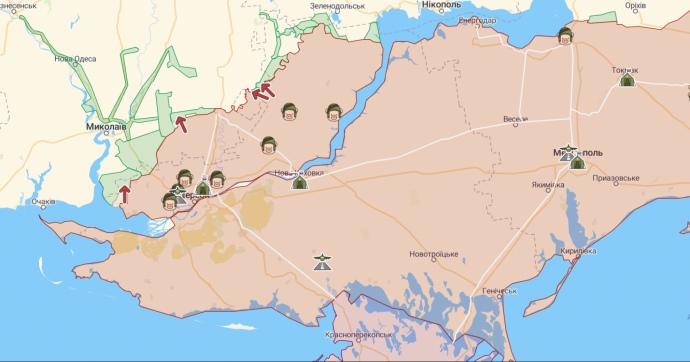Story of the day: Ukrainian Armed Forces go on offensive in Kherson Oblast. What is known about the fighting and the front line in the south of Ukraine

In the middle of July, Oleksii Reznikov, Ukraine’s Minister of Defence, said that Volodymyr Zelenskyy, President of Ukraine, had ordered the Ukrainian military to re-establish control over coastal regions in the south of Ukraine.
Many events have taken place in the south of Ukraine since that time, in particular, the Armed Forces of Ukraine have continuously struck bridges near Kherson and destroyed Russian ammunition storage sites in the region.
However, it was too early to call such actions a full-scale counteroffensive, although expectations in Ukraine’s society were high.
In early August, British intelligence reported that Russia's war with Ukraine was about to enter a new phase, with the fiercest fighting shifting to a front line roughly 350 km long, stretching southwest from Zaporizhzhia to Kherson, parallel to the Dnipro River.
On 29 August, Operational Command Pivden (South) and Kahovka Task Force announced counteroffensive actions in the south of Ukraine, in particular in Kherson Oblast, which the mass media and social media immediately perceived as the beginning of a major counteroffensive.
Ukrainska Pravda updates what is known about the events of 29 August and why the Kherson front is important for the Ukrainian and Russian sides.
What happened in Kherson Oblast on 29 August?
In the morning of 29 August, the Kakhovka Task Force released a video where one of the Russian occupiers said that the Ukrainian army is advancing on their positions in Kherson Oblast.
The breakthrough was also confirmed to Ukrainska Pravda by sources in the army. Later, the Armed Forces of Ukraine released an official statement that they were conducting offensive operations in the south.
In the evening, CNN, citing a source, reported that Ukrainian troops had liberated four villages from the Russian occupation: Nova Dmytrivka, Arkhanhelske, Tomyna Balka and Pravdyne (according to Ukrainska Pravda, this [the liberation] refers to other villages, and this information is being confirmed).
A military officer spoke to journalists, releasing a statement that the main area of the offensive was at Pravdyne, and that the main target was Kherson.
During the day, powerful explosions were heard in Kherson and Nova Kakhovka.
Also, according to Volodymyr Litvinov, the head of the Beryslav Regional Military Administration, the Armed Forces of Ukraine struck the Beryslav Machine Building Plant in Kherson Oblast, where the occupiers had concentrated the bulk of their armaments and troops.
The Ukrainian authorities warned local residents to evacuate urgently, because "the development of events could be powerful and dynamic."
Ukrainians were also warned: to stay as close as possible to safe places, stock up on food/water, and to double check first-aid kits. They were also cautioned to leave the nearby vicinity of any Russian military installations and to move as far away as is practical.
What does the front look like in Kherson Oblast?
The Russian occupiers took control of Kherson Oblast from the very beginning of the full-scale war.
As of the first day, 24 February, Ukraine lost control over a number of settlements, in particular over Henichesk, Nova Kakhovka and Oleshky. The occupiers approached Skadovsk.
During the following days, the Russians also captured a number of other settlements and a crossing over the Dnipro river controlling the approaches to the region’s centre.
During that battle, Ukrainian tank units heroically engaged the Russians, allowing Ukrainian troops to safely retreat to the right bank of the river.
Russian troops broke into Kherson on 1 March. However, the city government continued to work in the occupied city under the Ukrainian flag. Before the Russian led repression fully began, the city also regularly held peaceful protests against the occupation.
Russia only officially occupied the city council as of 25 April, when the front in Kherson Oblast had already stabilised. Mass repressions were launched in Kherson Oblast with the abduction of local residents.
The main battles in which the Armed Forces of Ukraine liberated the territories of Kherson Oblast took place in March and the first half of April. Since then, the front line has not changed significantly, and the sides have moved to a positional war. Unlike, for example, the Donetsk and Luhansk oblasts, where the Ukrainian army was forced to retreat from time to time.
According to data from the American Institute for the Study of War and the unofficial DeepState map of the fighting, as of the morning of 29 August, the front line looked like this:

Russia completely controlled Kherson Oblast along the border with Zaporizhzhia Oblast, part of which is also under occupation. The invaders approached the border with Dnipropetrovsk Oblast at a distance of approximately 10 kilometres.

The border with the Mykolaiv region was mostly also under the control of the Russian army, with the exception of some previously liberated areas in the west and northeast of Kherson Oblast.
How the Armed Forces went on a counteroffensive in Kherson Oblast
The General Staff began talking about a counteroffensive in the south of Ukraine at the end of May. Since that time, it has been officially reported several times that some territories had been liberated to the west and northwest of Kherson.
As of 1 August, according to the Kherson administration, 46 settlements had been liberated [from the Russian army].
During that time frame, military personnel operating in Mykolaiv and Kherson oblasts informed Ukrainska Pravda that the successes of the infantry’s offensive operations were relatively insignificant.
So, while the president declared "good news in the south" at the time, the military, which held the defence and counterattacked on one of the fronts, disclosed to Ukrainska Pravda that nothing much had generally changed there.
The infantry and artillery had a significant shortage of ammunition [to fire at the invaders]. Sources informed Ukrainska Pravda about pinpoint and rather difficult offensives. As Ukrainska Pravda knows, Lozove in Kherson Oblast, which was liberated [from the Russian army] at the end of July, was not won by the Ukrainian army on the first attempt.
At that time, the Institute for the Study of War explained: updates on the counterattack [of the Armed Forces of Ukraine] are limited and delayed due to the rural location of the front line, in an area mainly consisting of small settlements; consequently, data on troop movements and battles may be delayed.
At this time, the war in the region was characterised by two main trends:
- strikes on facilities used by occupiers: bridges, bases, storage sites, etc.;
- assassinations of representatives of the occupation authorities.
Thus, at the end of July, the Armed Forces of Ukraine attacked all three bridges over the Dnipro river in Kherson Oblast, which were controlled by the invaders: the Antonivka [road], Darivka and Kakhovka bridges.
"This has significantly weakened their (Russians - UP) logistical movements," explained Dmytro Butrii, then acting head of the Kherson administration.
British intelligence called the control of the crossings a key factor in the battles to regain Kherson Oblast.
The Antonivka road bridge is the largest and closest crossing to Kherson. Russian forces need it to rapidly transfer troops to the right bank of the occupied territories. This zone also includes Kherson. Without these bridges, the Dnipro river is a natural barrier for the occupying forces.
The Antonivka bridge was attacked by Ukraine three times in just one week at the end of July. At first it remained usable, but after 7 days it was so damaged that it became impossible to use it.
In August, strikes on bridges were repeated. The Armed Forces of Ukraine struck the second significant crossing - the Kakhovka bridge - making it unusable.
Operation of the Darivka bridge, which leads across the Inhulets River, a tributary of the Dnipro, has also stopped.
The occupiers began to use ferry crossings and in mid-August began to build a pontoon bridge.
However, according to British intelligence, the floating bridge "is likely to be vulnerable to offensive actions by Ukrainian forces."

On 29 August, the Armed Forces of Ukraine finally announced that they had destroyed almost all bridges in Kherson Oblast thanks to the HIMARS rocket launcher systems.
"Only pedestrian crossings reportedly remain intact for now. Thus, Russian forces have been cut off from supplies of weapons and reinforcements from Crimea," wrote the Kakhovka Task Force.
In addition to bridges, the army regularly reported strikes on other facilities: ammunition depots, ammunition points, artillery depots, etc. Such messages were reported by the Armed Forces of Ukraine even on the night before the start of an active counteroffensive.
At the same time, occasional reports of murders and attacks targeting both occupiers and collaborators in the occupied territories started appearing. In the spring, the pro-Russian blogger Valerii Kuleshov was shot as well as the "public figure" Pavlo Sharohradskyi, who, according to Ukrainian intelligence, was helping the Russian army with information about patriots, members of the ATO/Joint Forces Operation, their relatives, and local government workers. Pavlo Slobodchykov, assistant to Volodymyr Saldo, a known collaborator with the Russians, was also shot.
In June, the car belonging to the collaborator Yevhen Soboliev, the director of a correctional facility, was blown up. The Kremlin media reported that the occupier remained alive, but was hospitalised.
Information has appeared several times, in particular from Russian propagandists, about attempts on the life of Gauleiter Volodymyr Saldo, whom the invaders put in charge of Kherson Oblast. The Russians reported that Saldo was hospitalised and in a coma.
On 28 August, in Zaliznyi port, Oleksii Kovalov, a former member of the Ukrainian parliament who sided with Russia, was killed. He became the so-called "Deputy Head of the Kherson Oblast Administration for Agriculture", working for the Russians. It was already reported that his car had been blown up in June, but at that time Kovalov remained alive.
Why Kherson is important for Russians
On the first day of the full-scale war, the occupiers captured the Kakhovka Hydroelectric Power Plant. Its significance for Russia is difficult to overestimate, because the station is an important source of water supply from the Dnipro river to Crimea. Before the occupation, the peninsula received about 85% of its water this way.
In 2014, Ukraine blocked this supply, which consistently created economic problems for the occupiers and was the subject of political disputes in Ukraine from time to time.
After the capture of Kherson Oblast, the Russians resumed the operation of the canal. According to the State Environmental Inspectorate, as of 17 March, that is, only in the first 17 days after the destruction of the dam in Nova Kakhovka, the occupiers stole Ukrainian water worth almost 620 million hryvnias [approximately $16 million US dollars].
The second importance of the region for the Russian Federation is that this land corridor connects the east and Crimea [to the Russian mainland]. This gives the invaders the ability to transport and withdraw their troops, weapons and provide their army and occupying power with other necessary supplies.
Kherson, as the only regional centre that Russia managed to occupy since the beginning of the big war, also has political symbolism for Russian propaganda. "The most politically significant settlement occupied by Russia," as British intelligence calls it, adding:
"Its loss [the loss of Kherson] would seriously undermine Russia's attempts to portray the occupation as a success."
How the residents of Kherson Oblast are living
On 20 June, Hennadii Lahuta, the head of Kherson Oblast Military Administration, reported that 450,000-500,000 citizens remain in the occupied territory of Kherson Oblast. This is about 40-50% of the pre-war population.
The Ukrainian authorities repeatedly called on residents to leave the region after statements about a counteroffensive. However, currently the main route for evacuation is through occupied Crimea.
Another option is to go to Zaporizhzhia through occupied Melitopol and Vasylivka. However, the roads remain dangerous due to shelling and the lack of humanitarian corridors. In addition, the Ukrainian authorities in Melitopol reported on how the Russians were retaining thousands of people at the checkpoint in Vasylivka as human shields.
Kherson Oblast Military Administration regularly warned about the threat of a humanitarian disaster in Kherson Oblast. There were also reports of power outages there. The Russians jammed communications, and then put their own mobile operators into operation. At the beginning of April, it was said that stocks of food, medicine and fuel were running out in Kherson.
The Russian occupiers started terror and repression in the region. Local residents who disagree with the new "authority" are abducted and can be kept in unknown places for months without informing their relatives.
The Russians have repeatedly talked about the "referendum" with which they want to hold to legalise their invasive plans. However, they have still not managed to carry it out, or put the rouble in circulation, which they also threatened to do in the spring.
Ukrainians are forced to obtain Russian passports. Schools are being modified to adopt Russian curricula. However, the Ukrainian authorities and intelligence reported that the residents of Kherson, both teachers and students, are ignoring the new order in education. In response to that, according to the Armed Forces of Ukraine, the Russian occupiers are threatening to confiscate the property of parents who do not send their children to study in Russian schools in the temporarily occupied territories of Kherson Oblast.
Sonia Lukashova, Olha Kyrylenko, Ukrainska Pravda